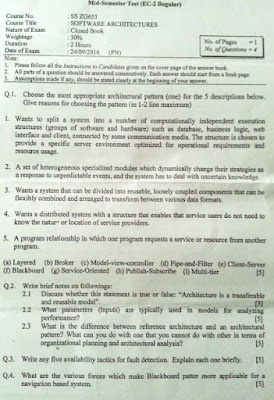Q1. Answer the following questions in brief
A. What are the two ways by which public cloud helps the customers to reduce their IT costs?
Answer:
- Flexible billing models enable customers to pay only for what they use.
- It reduces the capital expenditures required for setting up the infrastructure.
Answer: client, application, platform, infrastructure, server
B. What are the two limitations of SKI Virtualization?
Answer:
- It is not possible, for instance, to run different versions or even different patch levels of a particular operating system on the same machine.
- Whatever versions exist in the host, that same software will be provided in the guest. SKI also sacrifices the security and reliability provided by other virtualization methods.
Answer: Infrastructure as a Service.
D. How can a software development company leverage the PaaS cloud computing delivery model?
Answer:
Q2. Answer the following questions appropriately.
A. What is 3 - 4 - 5 rule of cloud computing?
Answer: This 3 - 4 - 5 rule stands for:
3 cloud service models
4 deployment models
5 essential characteristics of cloud computing infrastructure
RULE 3 - Cloud service models:
IaaS (Infrastructure as a Service):
The capability provided to the consumer is to provision processing, storage, networks, and other fundamental computing resources where the consumer is able to deploy and run arbitrary software, which can include operating systems and applications.
The consumer does not manage or control the underlying cloud infrastructure but has control over operating systems, storage, deployed applications, and possibly limited control of select networking components (e.g., host firewalls)
PaaS (Platform as a Service):
The capability provided to the consumer is to deploy onto the cloud infrastructure consumer created or acquired applications created using programming languages and tools supported by the provider.
The consumer does not manage or control the underlying cloud infrastructure including network, servers, operating systems, or storage, but has control over the deployed applications and possibly application hosting environment configurations
SaaS(Software as a Service):
The capability provided to the consumer is to use the provider's applications running on a cloud infrastructure. The applications are accessible from various client devices through a thin client interface such as a web browser (e.g., webbased email).
The consumer does not manage or control the underlying cloud infrastructure including network, servers, operating systems, storage, or even individual application capabilities, with the possible exception of limited user specific application configuration settings
RULE 4 - Deployment models:
Private Cloud (Single Org)
The cloud infrastructure is operated solely for a single organization. It may be managed by the
organization or a third party, and may exist on-premises or off-premises, Also called as “Enterprise Cloud”
Community Cloud (Multiple Org)
The cloud infrastructure is shared by several organizations and supports a specific community that has shared concerns (e.g., mission, security requirements, policy, or compliance considerations).
It may be managed by the organizations or a third party and may exist on-premises or off premises.
The cloud infrastructure is made available to the general public or a large industry group and is owned by an organization selling cloud services, Also called as “Internet Cloud”
Hybrid Cloud
The cloud infrastructure is a composition of two or more clouds (private, community, or public)
Leasing public cloud services when private cloud capacity is insufficient, Also called as “Mixed Cloud”
RULE 5 - Characteristics:
On-demand self-service:
Users can provision servers and networks with little human intervention.
Broad network access:
Any computing capabilities are available over the network. Many different devices are allowed access through standardized mechanisms.
Resource pooling:
Multiple users can access clouds that serve other consumers according to demand.
Cloud services need to share resources between users and clients in order to reduce costs.
Elasticity:
Provisioning is rapid and scales out or in based on need.
Metered or measured service:
One of the compelling business use cases for cloud computing is the ability to "pay as you go“, where the consumer pays only for the resources that are actually used by his applications.
















